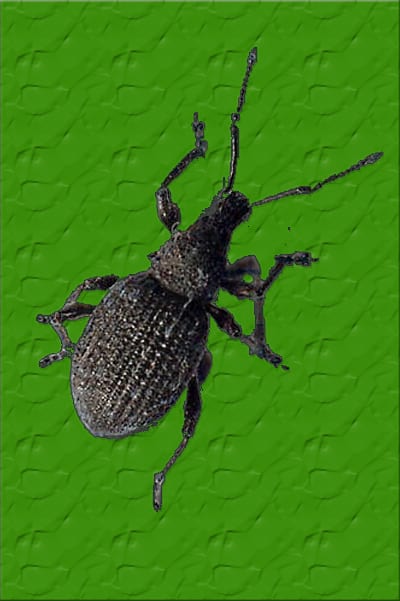Otiorhynchus_sulcatus
Black vine weevil is the most destructive and widespread of weevils. This weevil is found throughout most of northern North America from Maine to the Carolinas, and west to Washington and Oregon. It is also found in most of Canada and may have a flexible choice of foods
A favorite is yew which has led to another common name, the Taxus weevil it feeds on over 100 plants, trees, shrubs and flowers.
Adults are approximately ½” (12 mm) long, with an oblong shape and slate gray to blackish brown coloring, having pitted wings covered with short hairs for a speckled appearance. The weevil has a short, broad snout and elbowed antennae. It is difficult to distinguish black vine weevils from other Otiorhynchus weevils.
Adults and larvae have a wide variety of hosts, but prefer yew, hemlock, some rhododendrons and other broad-leaf evergreens like azalea, mountain laurel and euonymus. Adults can also feed on deciduous and herbaceous plants.
All adults are female in North American populations. Though adults are flightless, they are very active walkers. They are nocturnal and hide during the day in shady, moist locations like leaf litter, mulch, or on the stems of dense plants. If disturbed while on a stem, the adult will drop to the leaf litter where it becomes difficult to see due to effective camouflage.
Adults emerge in late May to early June and can live for several months (some adults may overwinter). Adults feed on leaf margins for two to three weeks before egg laying activity begins in late July, then alternate between egg laying and feeding for a month or more. Up to 500 eggs can be laid during this time and are set in the soil about 1-15″ (2-40 cm) deep, near the roots of host plants.
Larvae emerge in 10-14 days as off-white grubs with brown heads and in the characteristic C shape, looking similar to other root weevil larvae. They tunnel through the soil to feed on roots, growing to a length of 5/8″ (15 mm) by the end of the summer. Larvae overwinter in the soil as a pre-pupa, resume feeding in late May and early June before becoming milky white pupae with clearly visible legs in the spring. Pupation lasts about one month.
Usually there is one generation per year on trees and plants.
Adults feed on leaf margins, making crescent-shaped notches that are similar to those of other insects. Correct diagnosis in the field may be tricky. Feeding is more noticeable on rhododendrons or other broad-leaf plants but often more extensive on narrow-leaf evergreens, particularly yews. Adult feeding rarely causes serious injury.
Larvae feed on roots and, in the case of more mature larvae, bark on larger roots. Such feeding is exhibited by yellowing leaves, stunted growth and may eventually lead to plant death. The most extensive feeding damage occurs in the spring before pupation. High populations or overly damp soils in the fall can force larvae closer to the soil surface where they may feed on the stem, leading to girdling and subsequent death of plant.


